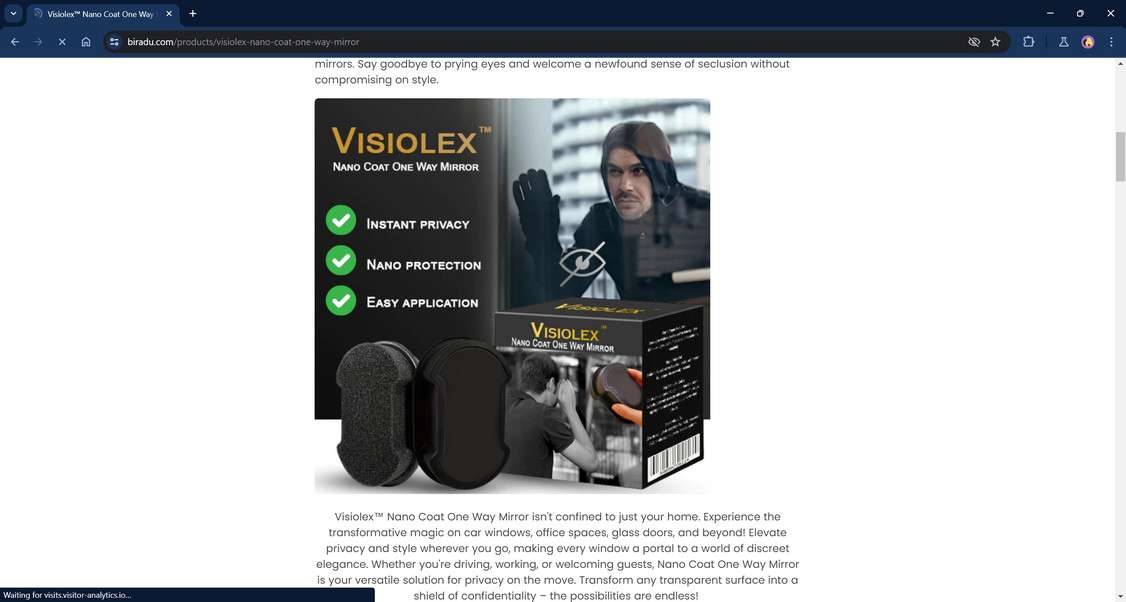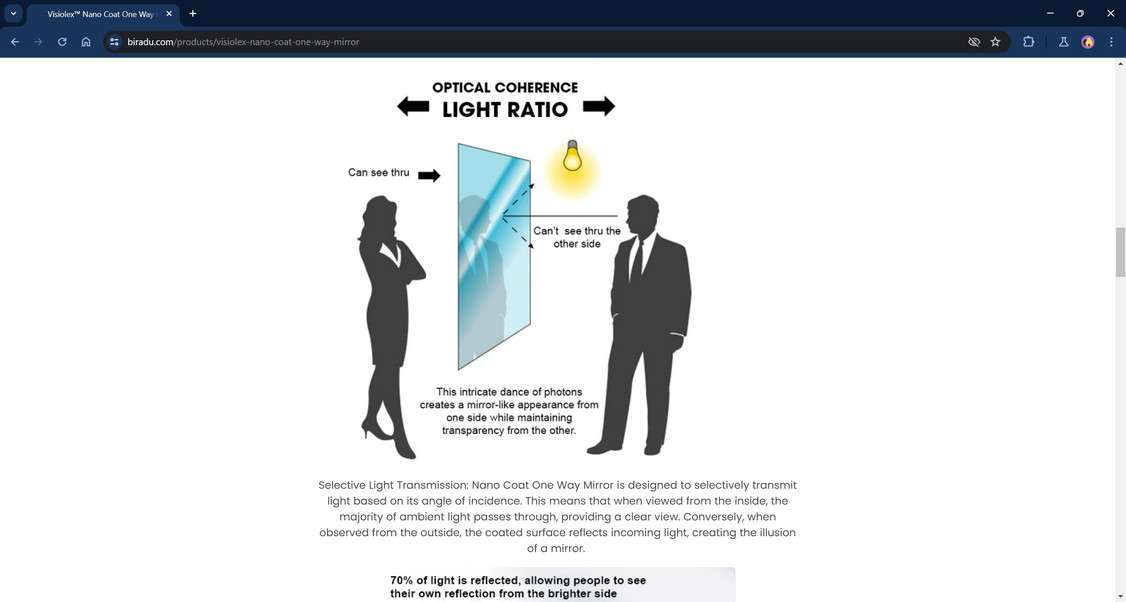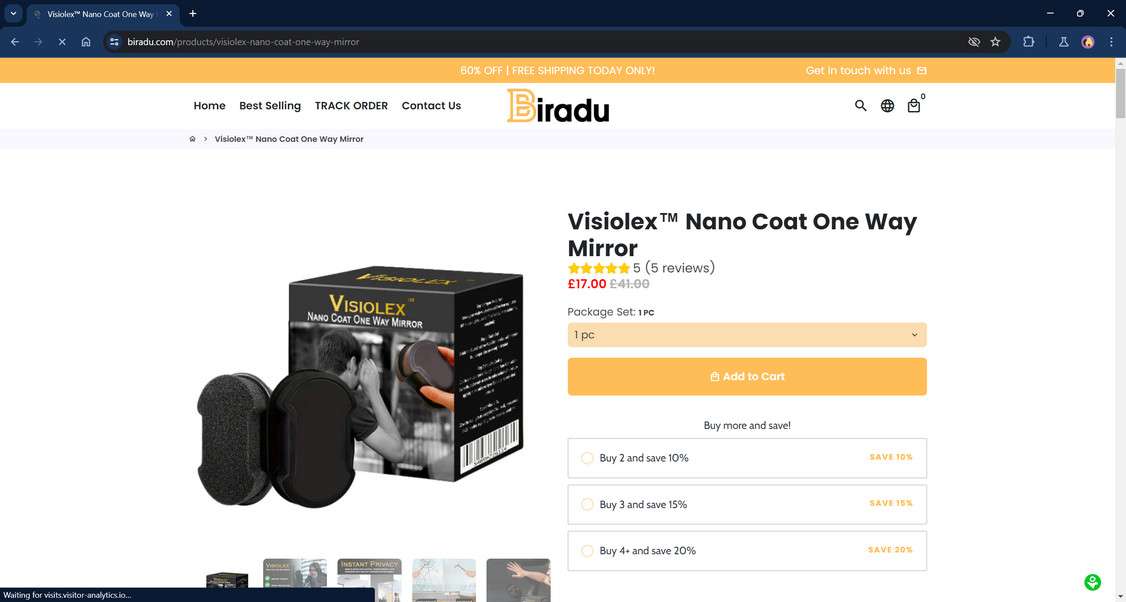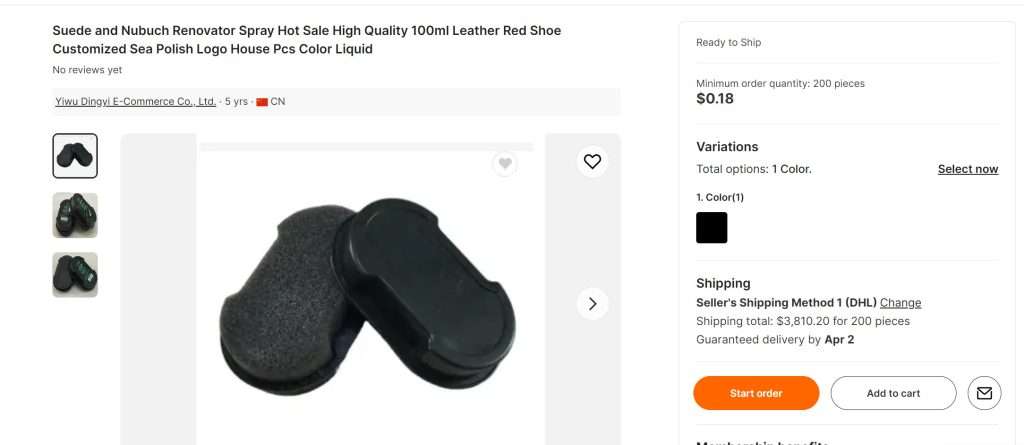The Visiolex Nano Coat One Way Mirror has recently exploded in popularity across social media, with flashy ads promising a miraculous film that can turn any window into a one-way mirror. However, behind the sleek marketing lies a sinister scam designed to prey on unwise consumers.
This in-depth article will uncover the troubling truth behind the Visiolex Nano Coat scam. We’ll explain how the scam works, analyze the deceptive marketing tactics, and provide advice for consumers who may have fallen victim to this predatory scheme. Equipped with the facts, readers can avoid this scam’s traps and warn others about its duplicitous nature.



This Article Contains:
Overview of the Visiolex Nano Coat One Way Mirror Scam
The Visiolex Nano Coat One Way Mirror scam is a worryingly prevalent fraud sweeping social media. This cunning scheme relies on flashy videos and sensational claims to peddle cheap wax shoe polish while promising a revolutionary film that transforms any glass into a one-way mirror.
In truth, the product is completely incapable of producing such an effect. Yet the scam manages to deceive countless victims thanks to slick websites, paid promotions, fake reviews, and suppression of refunds.
This expansive scam campaign targets victims across platforms like Facebook, Instagram, YouTube, and TikTok. Hundreds of sponsored ads promote the supposed “Nano Coat” product using edited footage misleadingly implying the product can turn ordinary glass opaque and mirror-like from one side while transparent from the other—a much-desired one-way mirror effect.
Duped viewers are funneled to elaborately designed scam sites promising unbelievable privacy and security powers with just a simple application. These sites use the bait of dramatic before-and-after videos, pseudoscientific explanations, and fake five-star reviews to sell the lie.
Victims are pressured to add multiple bottles to their cart and purchase quickly before the exaggerated limited supplies run out. Prices range from $25 to $89 per bottle, expensive for what victims later learn is a basic shoe polish they could buy for under $1.

Once purchased, the product is shipped in official-looking packaging to further the illusion. However victims soon discover the harsh truth upon applying this wax to their windows and realizing the fantastical claims were an utter farce. The wax does nothing to transform transparency or enable one-way visibility.
Understandably outraged, buyers try contacting the company for refunds, only to find endless obstacles and refusals. The criminals behind the sham anticipated this, engineering the scam to avoid refunds at all costs in order to profit. Attempts to report the scam or issue chargebacks also face resistance.
By the time victims realize the deception, the crafty scammers have already pocketed their money, moving onto the next round of unaware targets. The Visiolex Nano Coat scam continues spreading across social platforms, roping in consumer after consumer with its tempting pitch and polished facade.
Losses from this scam are estimated to be in the tens of thousands at least, if not higher. And many victims feel embarrassment at having been duped, making them less likely to report or warn others. The bottom line is this scam has been highly optimized to deceive and retain ill-gotten profits. Only through education and exposure can its propagation be limited. Consumers are advised to avoid this sham at all costs.
How the Visiolex Nano Coat One Way Mirror Scam Works
The Visiolex Nano Coat scam ensnares victims through a cunning multi-step process designed to create an aura of credibility around their worthless product. Let’s take an in-depth look at each step of how this devious scam operates:
Step 1: Eye-Catching Social Media Promotions
The scam typically starts with paid ads across social platforms like Facebook, Instagram, TikTok, and YouTube. These video ads portray incredible transformations of ordinary windows into one-way mirrors using the Nano Coat product. Dramatic before-and-after footage shows panes switching from transparent to opaque and reflective.
Of course, these videos are completely fabricated using video editing tricks. But they pique the curiosity of viewers, who find the idea of turning any window into a one-way mirror very enticing. The adrenaline rush of seeing such an unbelievable effect overrides critical thinking in the moment.
Step 2: Funneling to Polished Scam Websites
Intrigued viewers who click on the social media ads are taken to well-designed websites exclusively promoting the Nano Coat product. These scam sites use slick graphics, professional formatting, and scientific-sounding language to bolster perceptions of legitimacy.
Pages on the site overflow with raving reviews, dubious “lab results”, pseudo-scientific explanations, and too-good-to-be-true claims about the product’s capabilities. For example, the sites state the product relies on “optical coherence technology” to somehow turn glass one-way transparent. Such technical jargon confuses average consumers.
Step 3: Ordering Under False Pretenses
To drive sales, the scam sites utilize various psychological triggers and pressure tactics. Countdown timers create false scarcity. Upsells encourage buying multi-bottle packages. Fake testimonials manufacture trust. Claims of “viral sensations” generate FOMO.
These forces collectively manipulate victims into purchasing the Nano Coat bottles, often in multiples, for prices ranging from $25 to $95 – expensive for the useless wax they’ll actually receive.
Step 4: Delivering Worthless Products
A few days after order confirmation, victims receive their package containing the supposed “magic” one-way mirror solution. The bottles come packed in professional custom boxes with attractive branding and application instructions.
This maintains the charade as victims excitedly apply the liquid to their windows, expecting an amazing transformation. But inevitably, the wax does absolutely nothing to turn the glass into a one-way mirror. No amount of rubbing or coating makes windows opaque from one side.
At this point, the realization sets in that they’ve been scammed out of their hard-earned money.
Step 5: Blocking Refunds
As expected, swindled customers flood the company with angry refund requests. But boilerplate responses refuse returns or exchanges, instead suggesting the product simply didn’t work for that user. Some sites push replacement orders rather than refunds.
Each site is specifically designed to make obtaining refunds impossible, allowing the scammers to maximize their profits from the sham. Those who file credit card chargebacks face strenuous challenges proving the product was misrepresented.
In the end, the scammers walk away with the ill-gotten payments from thousands of victims. Rinse and repeat with a new website, and the cycle continues indefinitely until consumers wise up.
The Visiolex Nano Coat scam’s success stems from socially engineering victims through misdirection, deception, and psychological manipulation at every step. Only by scrutinizing remarkable claims can individuals protect themselves from these five ruthless stages of exploitation.
Deceptive Tactics Used to Promote the Scam Product
The success of the Visiolex Nano Coat scam relies on various deceptive tactics to fabricate credibility and trick victims into purchases. Some of the misleading marketing ploys include:
- Dramatic Before-and-After Videos – Highly produced videos show ordinary windows transforming into reflective panes, simulating the product’s supposed effects. In reality, these videos simply showcase one-way glass, not the actual product.
- Fake Scientific Jargon – Scam sites fill their copy with pseudoscientific terms like “optical coherence” and “selective light transmission” to sound legitimate. This language confuses and persuades victims.
- Misleading Metaphors – Descriptions use metaphors like “a portal to a world of discreet elegance” to romanticize the supposed effects. This gives the product an enticing mystique.
- Cookie-Cutter Reviews – Scam sites populate their pages with countless generic 5-star reviews to feign social proof. However, closer inspection reveals their duplicated phrasing.
- False Scarcity – Scam sites create false scarcity with claims like “only 5 units left!” This tricks victims into hurried purchases out of fear of missing out.
So in summary, an intricate web of deception convinces targets the product delivers on its unrealistic claims, overcoming consumer skepticism.
Scam Sold Under Other Brand Names
It’s important to note that this same Visiolex Nano Coat scam is also being perpetrated using other fictional brand names. Scammers routinely switch up the branding to avoid easy detection and appear as new offers.
Some other brand names the exact same scam has been reported using include:
- Furzero Nano Coat One Way Mirror
- iRosesilk Nano Coat One Way Mirror
- Seurico Nano Coat One Way Mirror
- NOWORDUP Nano Coat One Way Mirror




While the brand name differs on these scams, the claims, advertisements, and scam product remain the same. These sites feature the same videos of windows turning opaque, the same exaggerated claims of nanotech coatings, and the same pressures to purchase quickly.
The only difference is the name printed on the label of the useless wax product shipped to victims. So it’s critical to ignore the branding used and focus on the actual product, claims, and seller reputation.
No matter what slick name scammers slap on their sham product, it still remains an ineffective wax unable to convert windows into one-way mirrors. Consumers should steer clear of any suspicious liquid “nano coatings” promising unbelievable results. Changing the name doesn’t make the scam any less deceitful or the product any more functional. Stay vigilant.
What To Do If You Are a Victim of the Visiolex Nano Coat Scam
If you have fallen prey to the devious Visiolex Nano Coat scam, here are some important steps to take in response:
- Request an immediate refund – Contact the scam site immediately demanding a full refund. Cite that the product is not as described. Be firm and persistent.
- Report scam sites to authorities – File reports with the FTC, IC3, SEC, and cybercrime divisions in your state or country. Provide site details, order information, and payment records.
- Issue a chargeback – If refund requests fail, contact your bank or payment provider immediately to dispute the charges as fraudulent. Provide screenshots of the scam product/site as evidence. Act quickly as time limits for chargebacks apply.
- Spread awareness – Share your experience on social media and consumer complaint boards to warn others of this scam. Describe the deceptive tactics that misled you. Prevent others from being victimized.
- Seek mental health support – Scam victimization can induce trauma. Seek counseling or peer support groups to process emotions like violation, betrayal, shame, or embarrassment. Recognize you were manipulated and release misplaced self-blame.
- Take security precautions – Run antivirus scans and reset account passwords in case scammers gained computer access or personal information. Enable two-factor authentication where possible.
Remember, falling for a scam does not mean you were gullible or foolish. These schemes rely on highly refined deception tactics specifically designed to override skepticism. Seek justice, but go easy on yourself. With caution and awareness, consumers can sidestep these traps.
Here is a detailed, SEO optimized FAQ covering common questions related to the Visiolex Nano Coat scam:
Frequently Asked Questions About the Visiolex Nano Coat Scam
1. What is the Visiolex Nano Coat One Way Mirror scam?
The Visiolex Nano Coat scam is a fraudulent bait-and-switch scheme being promoted across social media. Scammers run ads showcasing a magical “one-way mirror” film that can turn any glass opaque. However, the actual product sent is a simple wax shoe polish that does not work as advertised. Customers are charged up to $89 for this worthless wax.
2. How does the Visiolex Nano Coat scam work?
The scammers first run flashy ads on sites like Facebook and YouTube showing unbelievable before-and-after videos of the Nano Coat product turning glass into a one-way mirror. Tricked users click these ads and are directed to polished websites exaggerating the product’s capabilities with fake reviews and claims. These sites pressure visitors to purchase the product quickly before claimed limited supplies run out. Victims who buy receive a bottle of wax shoe polish that obviously cannot transform windows into a one-way mirror. Refunds are then denied by the scammers to maximize illicit profits.
3. What platforms is the Nano Coat scam being advertised on?
The Visiolex Nano Coat ads have been reported on Facebook, Instagram, TikTok, Youtube, and many other major platforms. Scammers pay these networks to promote their deceitful ads and target users who are most likely to click. Video ads showing unbelievable product results spread widely on social media, luring in victims.
4. What does the real product look and act like?
Despite the claims, the actual Nano Coat product shipped to buyers is not a specialized one-way mirror solution. It is simply a generic wax shoe polish available for under $1 on sites like Alibaba. The wax comes in a small bottle with a Visiolex branded label. When applied to glass, it acts like any standard wax with no impact on transparency or reflection. It cannot turn windows into one-way mirrors.
5. What are the claims made about Visiolex Nano Coat on scam sites?
The scam sites promote many exaggerated and outright false claims about the capabilities of Nano Coat, including:
- Turns any glass into a one-way mirror
- Renders glass opaque and reflective on one side
- Uses advanced nanotechnology to bend light
- Films can be applied in minutes
- Simply wipe liquid on and let dry
- Provides instant, long-lasting privacy
These and other absurd claims are used to make the worthless wax seem like a unbelievable high-tech product.
6. How much does Visiolex Nano Coat cost on scam sites?
Scammers charge between $25 to $89 for Visiolex Nano Coat bottles on their sites. They often push special packages with 2 or more bottles and useless extras like warranty plans to drive up orders further. Given the actual wax costs mere pennies, this allows massive profits from the scam.
7. What are signs the Nano Coat website is a scam?
Red flags include exaggerated claims, fake reviews, limited stock warnings, pricing inconsistencies, grammatical errors, threatening language around returns, missing contact details, recent registration dates, and no physical address listed. These signals indicate an illegitimate shady operation.
8. Are there any legitimate Visiolex Nano Coat sellers?
No, there are currently no legitimate sites selling a genuine functioning Visiolex Nano Coat product as depicted in ads. All sites are scam operations looking to defraud victims of their money. No real one-way mirror solution exists that can be applied as simply as these scams claim. Avoid all sites selling Visiolex Nano Coat.
9. Can you get a refund if scammed by Visiolex Nano Coat?
Unfortunately, the scammers do everything possible to avoid refunds including ignoring requests or claiming the product works only on certain glass types. If you paid by credit card, you may contest the charges by filing a chargeback for receiving goods completely different from advertised. Act fast, as time limits apply. Others have rarely succeeded getting refunds from the shady operators.
10. How can I report a Visiolex Nano Coat scam site or ad?
If you come across a scam site or video ad for Visiolex Nano Coat, report it immediately. File a complaint with the FTC, IC3, SEC, and your state attorney general. Also alert the social network that hosted the ad and consider warning others privately or posting publicly about the scam tactics. The more awareness of this deceitful scheme, the less victims it can claim.
The Bottom Line
In closing, the Visiolex Nano Coat One Way Mirror scam relies on brazen deception to peddle useless wax as a miraculous privacy product. Through polished presentation, social engineering, manufactured reviews, and suppression of refunds, the scam reels in victims across social media.
Consumers should exercise extreme caution when evaluating sensational offers online. If a product seems too good to be true, it likely is. Scrutinize claims, read objective reviews, research the seller, and pay via credit card to minimize scam risk. Together, we can disrupt these schemes by exposing their predatory tactics and refusing to enable them with our money.
With this guide’s advice, anyone can avoid this scam’s traps. Forward knowledge of such schemes so fewer fall victim in the future. And if the unbelievable does happen, proceed with the utmost skepticism.










